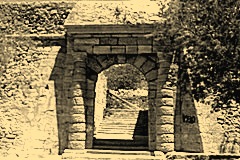The History of Spinalonga (Kalydon)
 Spinalonga was not always an island. In antiquity times it was united with the neighbouring peninsula named Kolokytha. There are different opinions on how it came to an island. Others believe it is the result of soil subsidence. The Venetian cartographer Vincenzo Koronelli reports that in 1526, the Venetians destroyed part of the peninsula and created the island, for defence purposes. There are also reports claiming that in 1897 a French admiral ordered to dig the isthmus connecting the peninsula with to the opposite shore.
Spinalonga was not always an island. In antiquity times it was united with the neighbouring peninsula named Kolokytha. There are different opinions on how it came to an island. Others believe it is the result of soil subsidence. The Venetian cartographer Vincenzo Koronelli reports that in 1526, the Venetians destroyed part of the peninsula and created the island, for defence purposes. There are also reports claiming that in 1897 a French admiral ordered to dig the isthmus connecting the peninsula with to the opposite shore.
The island of Spinalonga, which was opposite the ancient Olous (today named Elounda), creates a protective barrier. Due to its location, the island was fortified since ancient times to protect the entrance of the port of ancient Olous (one of the 100 cities mentioned by Homer in Crete). It is believed that the ancient Olous was destroyed at the 2nd BC century due to massive translocations of the land.
During the mid 7th century (DC) the wider area was abandoned by the locals due to the raids of the Arab pirates in the Mediterranean, until the mid 15th century when the Venetians started constructing salt-pans in the shallow water of the gulf.
Today, the remains of the city, and the saltworks are visible if you look at the sea, across the narrow road-bridge that connects Elounda with the peninsula Kolokytha.
 During the Venetian occupation of Crete, the Venetians built a defensive fortress on Spinalonga, which was so effective, that was last surrendered to the Turks in 1715, nearly 40 years after the conquest of the rest of Crete. Inside the fortress of Spinalonga locals had fled to escape the Turkish slavery, but after the conquest, the inhabitants were sold by the Turks as slaves or were led to the Turkish frigates, and were used as oarsmen. Over the next decades the island was inhabited by Turks.
During the Venetian occupation of Crete, the Venetians built a defensive fortress on Spinalonga, which was so effective, that was last surrendered to the Turks in 1715, nearly 40 years after the conquest of the rest of Crete. Inside the fortress of Spinalonga locals had fled to escape the Turkish slavery, but after the conquest, the inhabitants were sold by the Turks as slaves or were led to the Turkish frigates, and were used as oarsmen. Over the next decades the island was inhabited by Turks.
From 1903 to 1957 Spinalonga was used as leper colony. The lepers of Crete and later of the rest of Greece, where led there in order to isolate the patients from the healthy population, since there was no drug yet and the disease was considered highly contagious. For the locals Spinalonga is widely known as the island of the lepers, despites its great history.
After 1957 Spinalonga was abandoned for several decades. Today the island of Spinalonga is an archaeological site and a significant number of buildings have been restored. There are also become attempts to join the list of World Heritage of Unesco.

